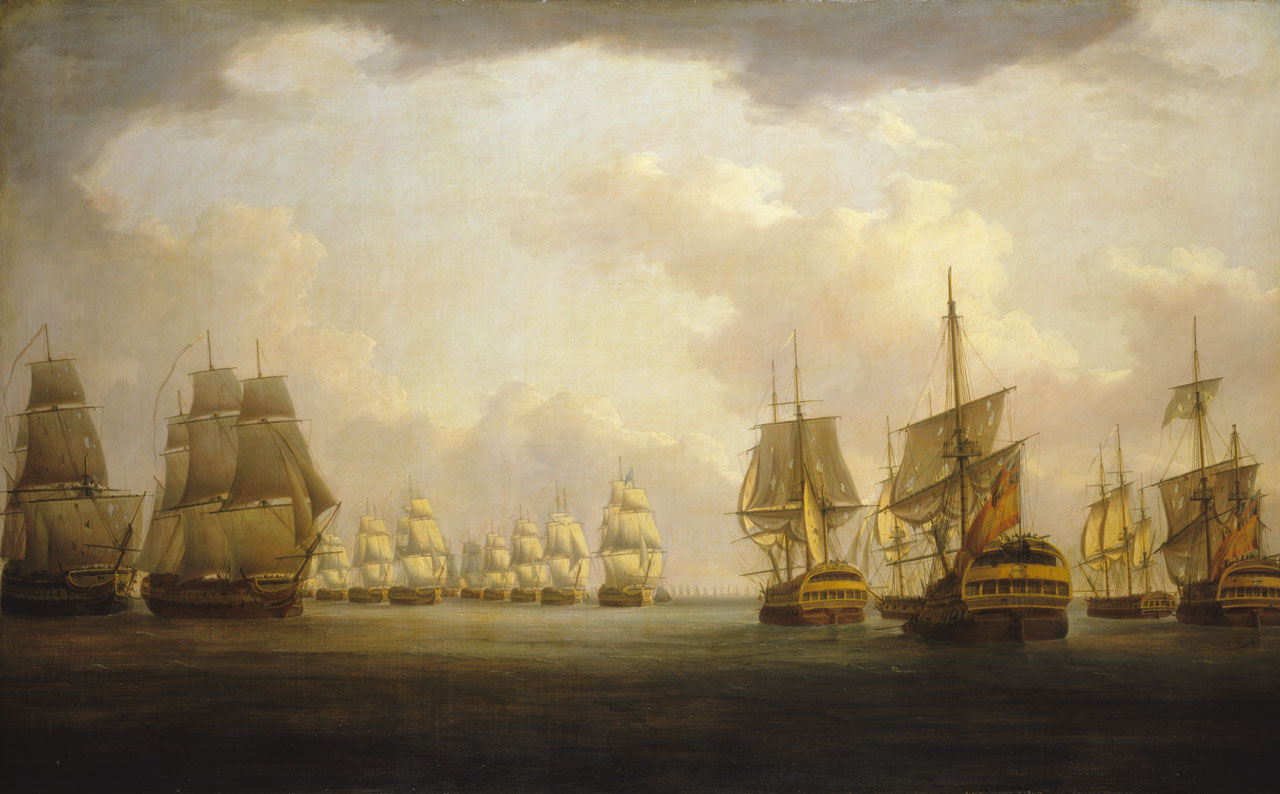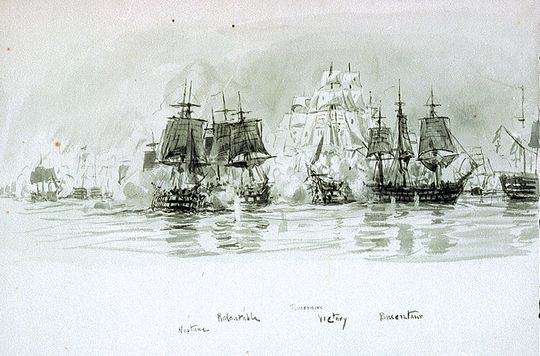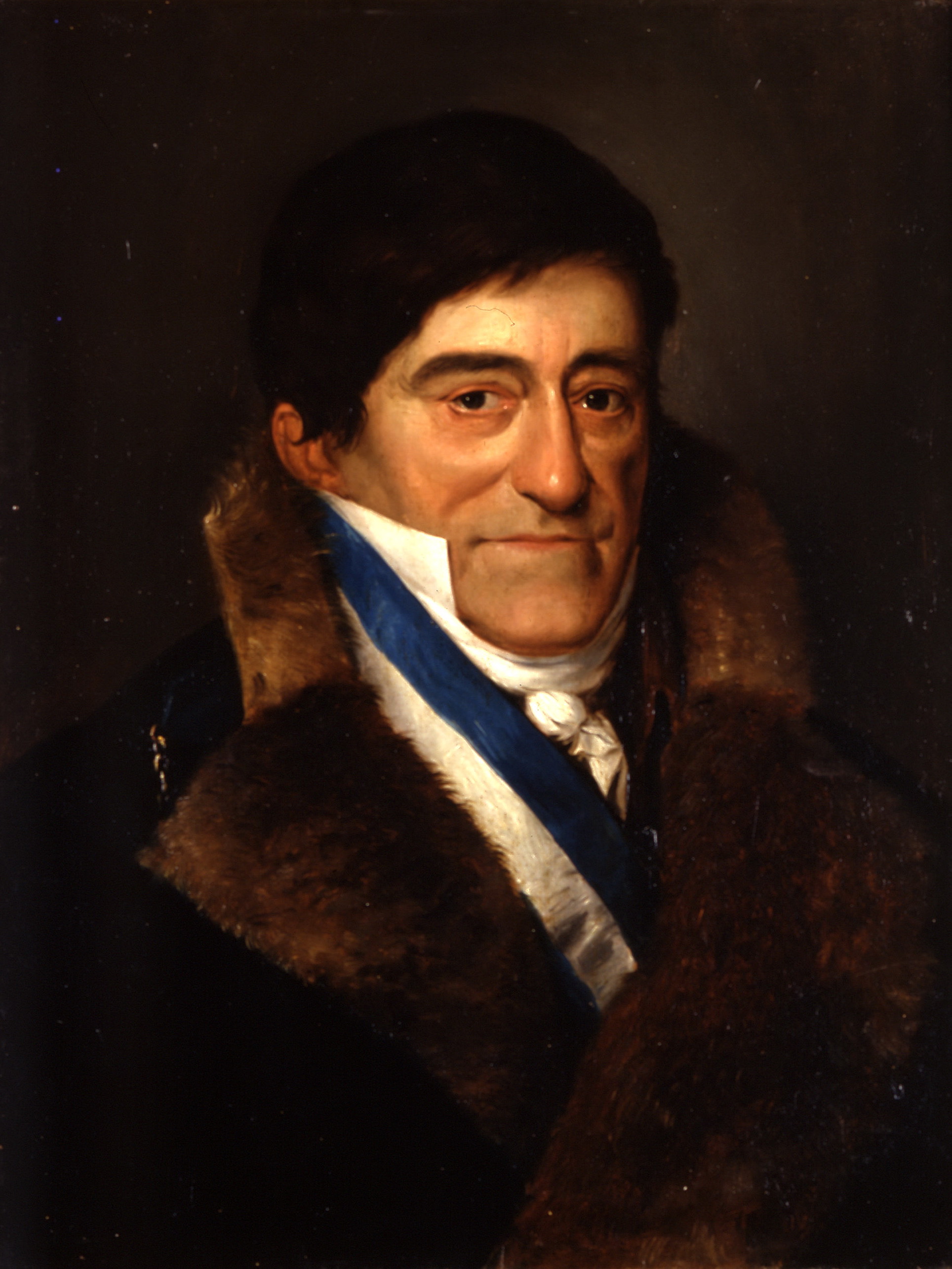|
Spanish Ship Príncipe De Asturias (1794)
''Príncipe de Asturias'' (Prince of Asturias) was a Spanish three-deck 112-gun ship of the line, named after Ferdinand, eldest surviving son of Charles IV of Spain and heir apparent with the title Prince of Asturias. She served during the Napoleonic wars escorting convoys, and fought at different times against both the British and French navies. Her invocation name was ''Los Santos Reyes'' (the Holy Kings). Construction She was built in Havana, Cuba in 1794 as part of the ''Santa Ana'' class designed by Romero de Landa. She was the last built of the eight ships of this class and was launched on 28 January 1794. Her construction was overseen by Honorato Bouyón. Service She left Havana on 26 February 1795 under the command of Brigadier Adrián de Valcárcel, and arrived in Cádiz on 17 May 1795 after escorting a valuable convoy. Cape St Vincent In 1797 she was commanded by Brigadier Antonio de Escaño y García, and was part of a squadron under Teniente General José de Córd ... [...More Info...] [...Related Items...] OR: [Wikipedia] [Google] [Baidu] |
Federico Gravina
Admiral Federico Carlos Gravina y Nápoli (born Federico Carlo Gravina Cruyllas; 12 August 1756 – 9 May 1806) was a Spanish Navy officer who served during the American Revolutionary War and the French Revolutionary and Napoleonic Wars. He died of wounds sustained during the Battle of Trafalgar. Explorer Jacinto Caamaño named the Gravina Island in Alaska in his honor. Origins and military career Gravina was born in Palermo, capital city of the Kingdom of Sicily. His father was Don Giovanni Gravina Cruyllas Moncada, Prince of Montevago, Duke of San Miguel and Grandee of Spain, and his mother was Donna Eleonora Napoli Montaperto, daughter of the Prince of Resuttano, also a Grandee of Spain. He was the third of five brothers: the eldest son, Girolamo, inherited the titles; two others became prelates, Pietro, cardinal archbishop of Palermo, and Gabriele (born Berengario), bishop of Catania. The Gravina Cruyllas were a prominent Sicilian aristocratic family of Catalan origins se ... [...More Info...] [...Related Items...] OR: [Wikipedia] [Google] [Baidu] |
José De Córdoba Y Ramos
José de Córdoba y Ramos (September 26, 1732 – April 3, 1815) was a Spanish Navy officer and explorer who sailed around the world and fought in several battles of the French Revolutionary Wars. Biography Born into a family of sailors, he was the son of Don Ramón Antonio de Córdova-Lasso de la Vega y Córdova-Lasso de la Vega, and Doña Mariana Josefa Ramos de Garay y Mexiá. Córdoba took to the seas at the age of 13. After sailing under Andrés Reggio, he was appointed to sail his own ship from Cádiz to Manila Bay via the Cape of Good Hope. In command of the frigate ''Astrea'', he set sail in April 1770 with a crew of 289 men. Arriving in Manila Bay, he affirmed that he only had two patients with scurvy, pointing out that the low incidence of scurvy was due to the gaspacho that he ordered to be given to the crew. Setting course back to Spain on January 6, 1771, he arrived at the Isla de León on August 1, 1771. Later in his career he sailed several times to the Philip ... [...More Info...] [...Related Items...] OR: [Wikipedia] [Google] [Baidu] |
French Ship Héros (1801)
''Héros'' was a 74-gun French ship of the line built at Rochefort from 1795 to 1801 by engineer Roland. She was one of the numerous ships designed by Jacques-Noël Sané. Career She took part in the French occupation of Santo Domingo, notably ferrying Toussaint Louverture to France after his arrest. She took part in the Battle of Trafalgar (21 October 1805) under Commander Poulain, and was one of the five French ships to survive the battle, although Poulain was killed at 13:15 and replaced by Lieutenant Conor.Fond Marine, p.331Troude, p.395 She subsequently returned to Cádiz.Roche. p.243 In the aftermath of the battle (28 October 1805), Jean Boniface Textoris, Chief Medical Officer of the French squadron, switched from the ''Bucentaur The bucentaur ( ; ''bucintoro'' in Italian language, Italian and Venetian language, Venetian) was the pleasure barge, ceremonial barge of the Doge of Venice, doges of Venice. It was used every year on Ascension Day (''Festa della ... [...More Info...] [...Related Items...] OR: [Wikipedia] [Google] [Baidu] |
French Ship Argonaute (1798)
''Argonaute'' was a 4th rank, 74-gun built for the French Navy during the 1790s. Completed in 1799, she played a minor role in the Napoleonic Wars. Description Designed by Jacques-Noël Sané, the ''Téméraire''-class ships had an length of , a beam of and a depth of hold of . The ships displaced 3,069 tonneaux and had a mean draught of . They had a tonnage of 1,537 port tonneaux. Their crew numbered 705 officers and ratings during wartime. They were fitted with three masts and ship rigged.Winfield & Roberts, p. 87 The muzzle-loading, smoothbore armament of the ''Téméraire'' class consisted of twenty-eight 36-pounder long guns on the lower gun deck and thirty 18-pounder long guns on the upper gun deck. On the quarterdeck and forecastle were a total of sixteen 8-pounder long guns. Beginning with the ships completed after 1787, the armament of the ''Téméraire''s began to change with the addition of four 36-pounder obusiers on the poop deck (). Some ships had instead twen ... [...More Info...] [...Related Items...] OR: [Wikipedia] [Google] [Baidu] |
French Ship Algésiras (1804)
''Algésiras'' was a 74-gun French ship of the line built at Lorient in 1804, named after the Battle of Algeciras. In 1805 she sailed to the West Indies with where they joined a French fleet under Vice-Admiral Villeneuve. In October 1805 she took part in the Battle of Trafalgar, under Rear Admiral Charles Magon. She was engaged by at point-blank range, and Magon attempted a boarding, but the boarding party was annihilated by British fire which killed all but one of the party, who was made prisoner. Magon was killed. The fight went on for an hour with ''Tonnant''s starboard guns duelling with the ''Algésiras'', the port guns with , and the forward guns aimed at the . ''Algésiras'' finally surrendered to ''Tonnant'' at around 14:30. During the storm after the battle, her crew rose up against the British prize crew, and recaptured the ship. She sailed to Cádiz flying French colours. On 14 June 1808 she was captured by the Spanish along with all the other French ships ... [...More Info...] [...Related Items...] OR: [Wikipedia] [Google] [Baidu] |
French Ship Neptune (1803)
''Neptune'' was a 80-gun ship of the line of the French Navy. Built during the last years of the French Revolutionary Wars she was launched at the beginning of the Napoleonic Wars. Her brief career with the French included several major battles, though she spent the last 12 years of her life under the Spanish flag. ''Neptune'' was built at Toulon and launched in 1803. She was commissioned in time to join an abortive attempt to break the British blockade of the port in October 1804, but the fleet was forced back to port by bad weather. She sailed again with the fleet, under Vice-Admiral Pierre-Charles Villeneuve, in early 1805, and this time succeeded in breaking out of the Mediterranean, and sailing to the West Indies, where the fleet was joined by Spanish ships. After achieving little in the Caribbean, the fleet sailed back to Europe, where they were engaged by a British fleet in the Battle of Cape Finisterre. ''Neptune'' saw little action, and was relatively unscathed. She to ... [...More Info...] [...Related Items...] OR: [Wikipedia] [Google] [Baidu] |
Capture Of The Rosily Squadron
The Capture of the Rosily Squadron, also known as the Battle of Poza de Santa Isabel, took place on 14 June 1808, in Cádiz, Spain, following the Dos de Mayo Uprising against French troops in Madrid. Five ships of the line and a frigate of the French Imperial Navy were in the port, having remained there under a British blockade since the Battle of Trafalgar in 1805. After an engagement with the Spanish lasting five days, French Admiral François Étienne de Rosily-Mesros surrendered his entire squadron with the four thousand seamen then on board. Background The Spanish conventional warfare had started with the Battles of El Bruch. The spring of 1808 saw a deterioration in relations between erstwhile allies Spain and France, culminating in rebellions against the Spanish king Charles IV, leading to a French occupation and the placing of Joseph Bonaparte on the Spanish throne. Under difficult circumstances, Rosily endeavoured to gain enough time for the arrival at Cádi ... [...More Info...] [...Related Items...] OR: [Wikipedia] [Google] [Baidu] |
Juan Ruiz De Apodaca, 1st Count Of Venadito
Juan José Ruiz de Apodaca y Eliza, 1st Count of Venadito, OIC, OSH, KOC (3 February 1754 – 11 January 1835) was a Spanish Navy officer, nobleman and colonial administrator who served as the viceroy of New Spain from 20 September 1816 to 5 July 1821 during the Mexican War of Independence. Military career Ruiz de Apodaca was born in Cádiz into a family of renowned Basque merchants. He began his military career on November 7, 1767 as part of the marine guard, and three years after he was named frigate lieutenant, being continuously promoted until reaching the rank of naval lieutenant on May 23, 1778. At this time he also married Maria Rosa Gaston with whom he had seven children. He sailed as a junior officer throughout the northern and the southern hemisphere on various ships. He was commissioned to go to Tahiti on the friguate ''Aguila'', where he gathered much info about the area, drawing up charts of the island and its ports. He was promoted to frigate captain in ... [...More Info...] [...Related Items...] OR: [Wikipedia] [Google] [Baidu] |
Peninsular War
The Peninsular War (1808–1814) was fought in the Iberian Peninsula by Kingdom of Portugal, Portugal, Spain and the United Kingdom of Great Britain and Ireland, United Kingdom against the invading and occupying forces of the First French Empire during the Napoleonic Wars. In Spain, it is considered to overlap with the Spanish War of Independence. The war can be said to have started when the First French Empire, French and History of Spain (1808–1874), Spanish armies Invasion of Portugal (1807), invaded and occupied Portugal in 1807 by transiting through Kingdom of Spain (1810-1873), Spain, but it escalated in 1808 after First French Empire, Napoleonic France occupied History of Spain (1808–1874), Spain, which had been its ally. Napoleon Bonaparte Abdications of Bayonne, forced the abdications of Ferdinand VII of Spain, Ferdinand VII and his father Charles IV of Spain, Charles IV and then installed his brother Joseph Bonaparte on the Spanish throne and promulgated the ... [...More Info...] [...Related Items...] OR: [Wikipedia] [Google] [Baidu] |
French Frigate Thémis (1799)
''Thémis'' was a 40-gun of the French Navy. Service Launched at Rochefort Arsenal, Rochefort in 1799 and commissioned in 1801,Winfield & Roberts, p.131 she took part in the Battle of Cape Finisterre (1805), Battle of Cape Finisterre (22 July 1805) and in the Battle of Trafalgar (21 October 1805). During Trafalgar she was commanded by Captain Nicolas Joseph Pierre Jugan. After the battle she towed the Spanish ships of the line Spanish ship Principe de Asturias (1794), ''Principe de Asturias'' and ''Spanish ship Santa Ana (1784), Santa Ana'' to safety in Cádiz. Lamellerie's expedition Still under the command of Captain Jugan, on 26 February 1806 she took part in Lamellerie's expedition, a squadron commanded by the most senior frigate captain in Cádiz, Captain Louis-Charles-Auguste Delamarre de Lamellerie. The squadron's mission was to breakout out of Cádiz into the Atlantic and raid British merchant shipping.Gardiner, p. 25 It consisted of other French frigates who had surviv ... [...More Info...] [...Related Items...] OR: [Wikipedia] [Google] [Baidu] |
Frigate
A frigate () is a type of warship. In different eras, the roles and capabilities of ships classified as frigates have varied. The name frigate in the 17th to early 18th centuries was given to any full-rigged ship built for speed and maneuverability, intended to be used in scouting, escort and patrol roles. The term was applied loosely to ships varying greatly in design. In the second quarter of the 18th century, what is now generally regarded as the 'true frigate' was developed in France. This type of vessel was characterised by possessing only one armed deck, with an unarmed deck below it used for berthing the crew. Late in the 19th century (British and French prototypes were constructed in 1858), a type of powerful ironclad warships was developed, and because they had a single gun deck, the term 'frigate' was used to describe them. Later developments in ironclad ships rendered the 'frigate' designation obsolete and the term fell out of favour. During the Second World War ... [...More Info...] [...Related Items...] OR: [Wikipedia] [Google] [Baidu] |
Flagship
A flagship is a vessel used by the commanding officer of a group of navy, naval ships, characteristically a flag officer entitled by custom to fly a distinguishing flag. Used more loosely, it is the lead ship in a fleet of vessels, typically the first, largest, fastest, most heavily armed, or best known. Over the years, the term "flagship" has become a metaphor used in industries such as broadcasting, automobiles, education, technology, airlines, and retail to refer to their highest quality, best known, or most expensive products and locations. Naval use In common naval use, the term ''flagship'' is fundamentally a temporary designation; the flagship is wherever the admiral's flag is being flown. However, admirals have always needed additional facilities, including a meeting room large enough to hold all the captains of the fleet and a place for the admiral's staff to make plans and draw up orders. Historically, only larger ships could accommodate such requirements. The ter ... [...More Info...] [...Related Items...] OR: [Wikipedia] [Google] [Baidu] |





